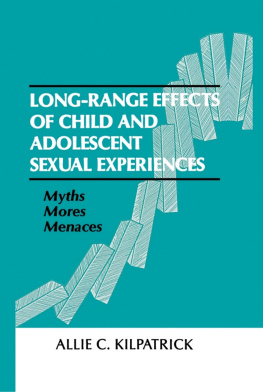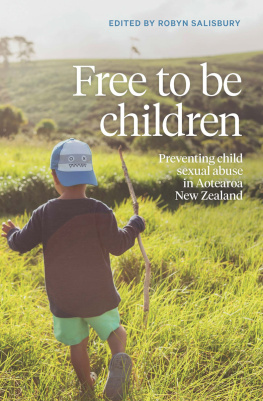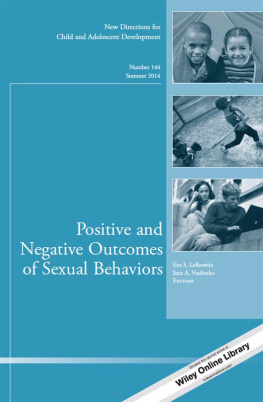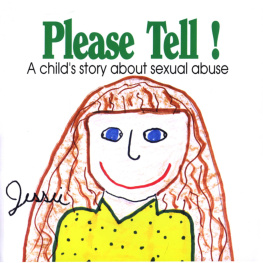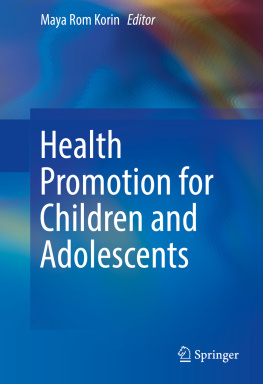Long-Range Effects of Child and Adolescent Sexual Experiences
Myths, Mores, and Menaces
Long-Range Effects of Child and Adolescent Sexual Experiences
Myths, Mores, and Menaces
Allie C. Kilpatrick
University of Georgia

First Published by
Lawrence Erlbaum Associates, Inc., Publishers
365 Broadway
Hillsdale, New Jersey 07642
Transferred to Digital Printing 2009 by Routledge
270 Madison Ave, New York NY 10016
27 Church Road, Hove, East Sussex, BN3 2FA
Copyright 1992, by Lawrence Erlbaum Associates, Inc.
All rights reserved. No part of the book may be reproduced in any form, by photostat, microform, retrieval system, or any other means, without the prior written permission of the publisher.
Library of Congress Cataloging-in-Publication Data
Kilpatrick, Allie C.
Long-range effects of child and adolescent sexual experiences:
myths, mores, and menaces / by Allie C. Kilpatrick.
p. cm.
ISBN 0-8058-0913-9 (c). ISBN 0-8058-0914-7 (p)
1. Child molestingUnited States. 2. Sexually abused children
Mental healthUnited States. 3. Sexually abused teenagersMental
healthUnited States. 4. Children and sexUnited States.
I. Title.
[DNLM: 1. Child Abuse, Sexual. 2. Child Abuse. Sexual
complications. 3. Child Abuse, SexualUnited Statesstatistics.
4. Social EnvironmentUnited States. WA 320 K48L]
RJ506.C48K56 1992
618.928583dc20
DNLM/DLC
| for Library of Congress | 91-28233 |
| CIP |
Publisher's Note
The publisher has gone to great lengths to ensure the quality of this reprint but points out that some imperfections in the original may be apparent.
This book is lovingly dedicated to my parents who taught me mores and morals, my husband who helps me identify myths, and my children who provide merriment (and are definitely not menaces).
Most of us harbor strong beliefs and convictions about the long-range effects of sexual experiences encountered during childhood and adolescence. Few of us ever have the opportunity to obtain or examine credible evidence about the long-range consequences of the sexual encounters that most of us have experienced during our early years. This book provides an opportunity to learn a great deal about the effects of early sexuality on adult functioning. It does a great deal more.
Many will be shocked and dismayed over the legally sanctioned sexual treatment of children that the author describes. She begins with the writings of our earliest civilizations and brings us up to date so that we can see how beliefs, attitudes, and legal protections have changed over the centuries. The comprehensiveness of her historical review of legal protections from sexual abuse is outstanding in light of its brevity. More importantly, it lays the foundation for addressing a number of agonizing issues throughout the remainder of the book.
Early on the reader will discover that one aim of this book is to debunk some of the myths about the sexual abuse of children. Such an effort is filled with peril because there is always the grave risk of being misunderstood or misinterpreted. Considerable intellectual courage is required when one sets out to collect factual evidence concerning matters that are believed to have been long since settled. This is especially true if the facts tend to refute passionately held beliefs about so sensitive and important a topic as childhood sexual experiences.
In this regard it is difficult to judge wherein a book such as this makes its largest contribution. On the one hand, it is full of sound evidence that will be useful in a great many ways and to a great many who are concerned about human sexuality and the protection of our children from abuse and harm. On the other hand, one of the greatest merits of the book is its effort to examine the equally serious matters of values and definitions with respect to such terms as abuse, neglect, and harm. Nowhere does the author pretend to offer final answers on such matters. However, few can read this book without being challenged to review once more their long held positions and beliefs about such topics.
An important consequence of this effort is that it helps all of us to better understand how the facts that emerge from an investigation are inextricably connected to the values and beliefs of those who shape the research questions and the design of data collection instruments. This is not to suggest that the influence of beliefs and values is a bad thing. To the contrary, they are essential and cannot be eliminated. Nor should they be. Yet, if beliefs and values do, and must, shape the nature of our investigative questions it is imperative that we understand them and the influence they have on shaping the facts that are obtained. This book presses these issues forward with such great clarity that it should be regarded as essential reading for any who will conduct research in human sexuality. It is equally essential reading for those who would be the consumers of published research in this and related areas of human endeavor.
Beliefs and values are central to the purposes for conducting research of this kind but they play a far greater role in shaping such vital tools as the assumptions and definitions that must be in place for the conduct of such studies. In this regard, the author has made an outstanding contribution in challenging blind adherence to beliefs, values, and definitions that may have served more to confuse than to clarify. Worse yet, they may have led to early findings that have been as misleading as they have been informative.
In this regard, the reader is treated to a brief but excellent review of previous research that has been conducted on the long-range consequences of early sexual experiences. One leaves that review with a better understanding of the strengths and weaknesses of prior efforts to understand a vital but surprisingly ignored topic. And there are many other contributions that should not be ignored. The book has much to say about continuing issues for future research and it addresses important methodological problems that many will want to consider for the design of future studies of human sexuality. The book concludes with an excellent discussion of the relevance of findings to treatment, service delivery, and future research and scholarship.
Always discursive and illustrative, rather than being accusatory, the author has performed an outstanding service by identifying the terrible consequences that can come to children when researchers, scholars, and practitioners allow themselves to be guided by theories that have never been validated. Among those consequences are the punishment of victims and the failure to help those who are in great need of assistance and protection. In confronting these examinations the reader is struck by the relevance of theory to the affairs and concerns of real children with real instances of abuse. One sees how grave can be the consequences of flawed and invalidated theory and how useful can be a simple theory that is well grounded in strong evidence. In these portions of the book the author presents her strongest case for the support and conduct of research into the matters of child and adolescent welfare.
The messages and findings of this book will be many things to many people. Some will be disheartening, disturbing, and outrageous. Others will be informative, hopeful, and enlightening. Few will be dispassionate in meaning or consequence for those who are concerned about the welfare of our children. Yet, in considering the materials contained in this book it may be useful to keep in mind the perpetual unwillingness of our culture to deal openly and honestly with matters related to the sexuality of our children.

